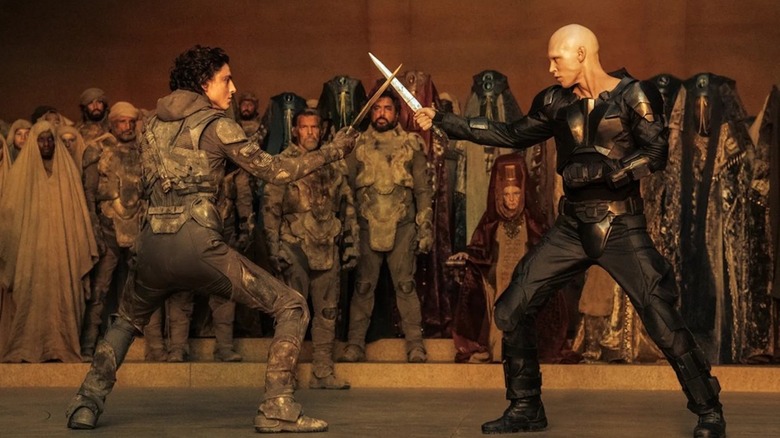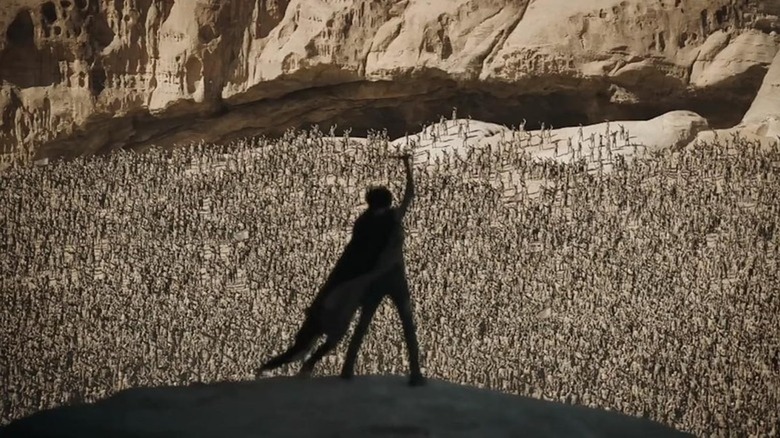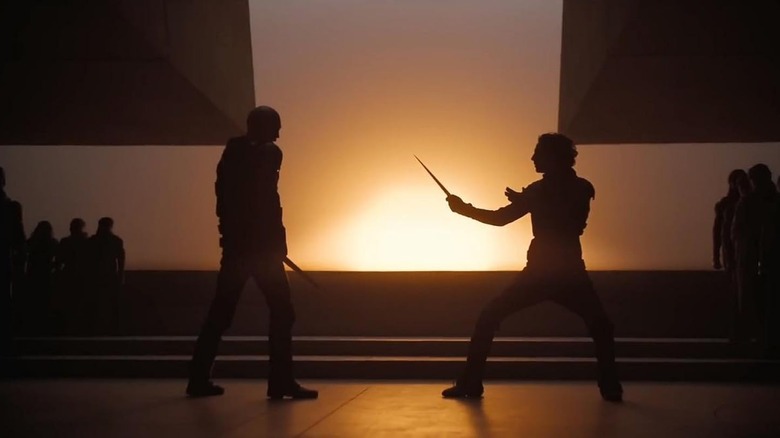How Dune 2's Final Fight Between Timothée Chalamet And Austin Butler Came Together
We may receive a commission on purchases made from links.
By this point, we all know how fortunate we are that we got to see Denis Villenueve's two-part adaptation of Frank Herbert's sci-fi novel "Dune" in its entirety. Warner Bros. clearly believed in Villenueve as a visionary by giving him a $160 million budget to adapt the first chunk of Herbert's book after the filmmaker's last movie for the studio, "Blade Runner 2049," severely underperformed commercially. The gamble itself wasn't on Villenueve. WB knew he could build massive worlds and tell a compelling story within them. It was on the material to sell itself. Was a nuanced tale of political intrigue (and, eventually, full-on warfare) set on a desert planet of interest to mainstream audiences?
Villenueve's "Dune" was compelling enough to score a $41 million theatrical opening despite debuting on HBO Max the same day. A significant number of moviegoers understood this was a big-screen experience, and they registered their enthusiasm with an A- Cinemascore.
So WB rewarded Villeneuve with a budget boost, and let him make "Dune: Part Two" on his own terms. He validated their faith by delivering a blockbuster that, to date, has made over $700 million worldwide.
While Herbert's "Dune" is still popular 59 years after its initial publication, it is not as widely read as the myriad YA book series that supply studios with their literary IPs nowadays. This meant Villenueve could take liberties with the novel without incurring the social media wrath of a fandom big enough to support a theme park. But much like Peter Jackson with the "Lord of the Rings" trilogy, Villenueve's alterations are largely true to the spirit of the material. This is very evident in his tweaking of the climactic fight between Paul Atreides (Timothée Chalamet) and Feyd-Rautha Harkonnen (Austin Butler).
A War Room worthy of a classic hand-to-hand duel
According to Tanya Lapointe and Stefanie Broos' "The Art and Soul of Dune: Part Two," the duel, which determines the future of the throne of the Known Universe, was given extra weight by the impressive size of the War Room set. It took 22 weeks to construct the set. Once finished, cinematographer Greig Fraser, to capture the awe-inspiring sight of the sunrise pouring in through the vast opening that looks out onto the desert expanse, had to use 800 separate LED light panels. This wasn't quite Joseph L. Mankiewicz's "Cleopatra," but this scale certainly dwarfs most major studio productions.
And in the middle of luscious extravagance is a savage fight to the death between a would-be usurper and the champion of reigning Emperor Shaddam IV (Christopher Walken). The stakes couldn't be higher for everyone in the War Room, but they are particularly perilous for Paul and Feyd-Rautha. At the end of this clash, one of them will no longer draw breath.
It's as pivotal moment in the film as it is in the book, but Villenueve, to give the sequence an extra charge, eliminated one of the key elements of the battle from Herbert's novel.
Feyd-Rautha fights Paul fair and ferociously square
In Herbert's "Dune," there is a sense that Paul is the superior warrior. Feyd-Rautha is formidable, but you feel Paul has the upper hand. So does Feyd, who gives himself a lethal advantage by poisoning his blade. Though we're sucked into the sequence as written, a part of us knows no real harm can come to Paul because one knick of his skin with Feyd's blade would mean certain death.
Villeneuve understood this, and evened the playing field. "It needs to feel dangerous," he told Lapointe and Broos, "As though Paul has met his equal."
So, in "Dune: Part Two," Feyd forgoes the poison and fights Paul as if he is a worthy opponent. This means Paul can sustain far more damage to his body than he does in the book, and Villenueve boldly follows through on this potential.
As for the fight choreography, the actors eagerly threw themselves into their combat training. Indeed, when it came time to shoot the sequence on set, they got a little carried away. According to supervising stunt coordinator Lee Morrison:
"They're both amazing actors, and physically very talented. Together, they were constantly pushing each other, taking it to another level. At the speed they were fighting, we had to tell them to slow down because we couldn't read what was happening in the fight. That's how fast they were going."
So there you have it: a memorable fight scene driven by the actors' passion, heightened by the set and light design and rendered a tad unpredictable by the director's willingness to depart from the text. "Dune: Part Two" is top-tier filmmaking across the board, and the payoff for these efforts is why we go to the movies.


